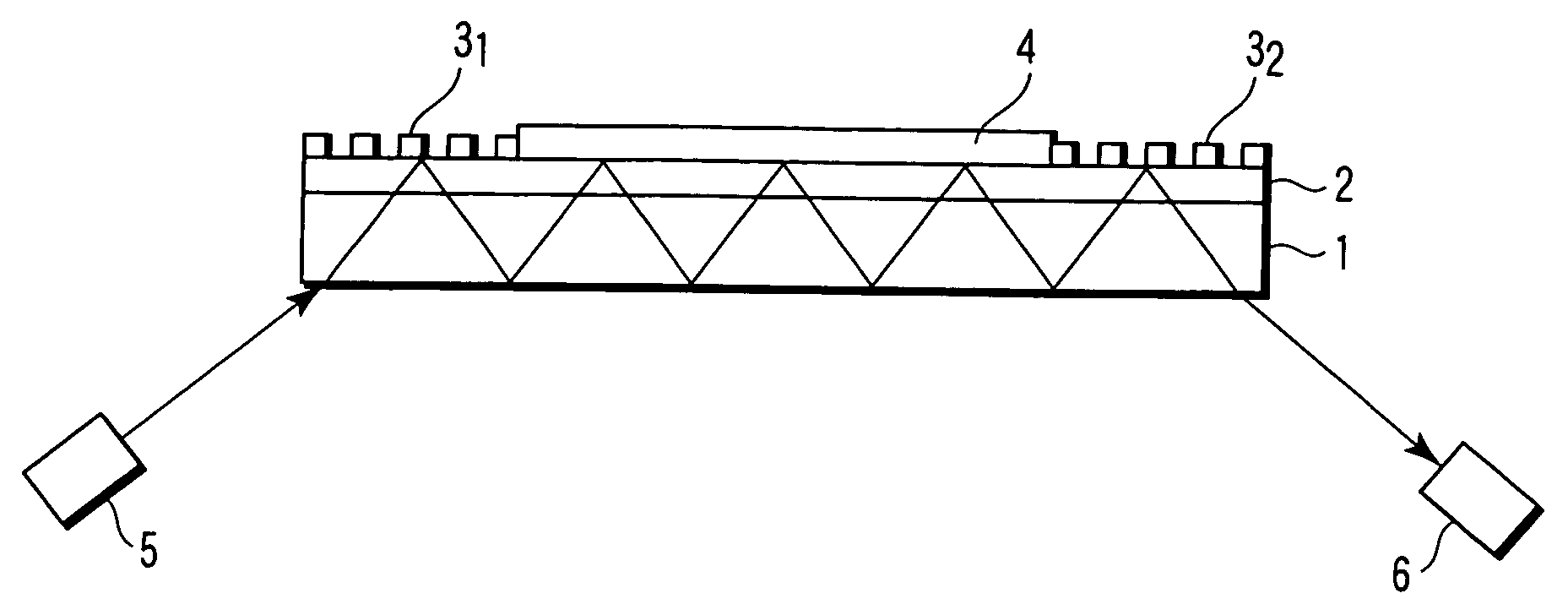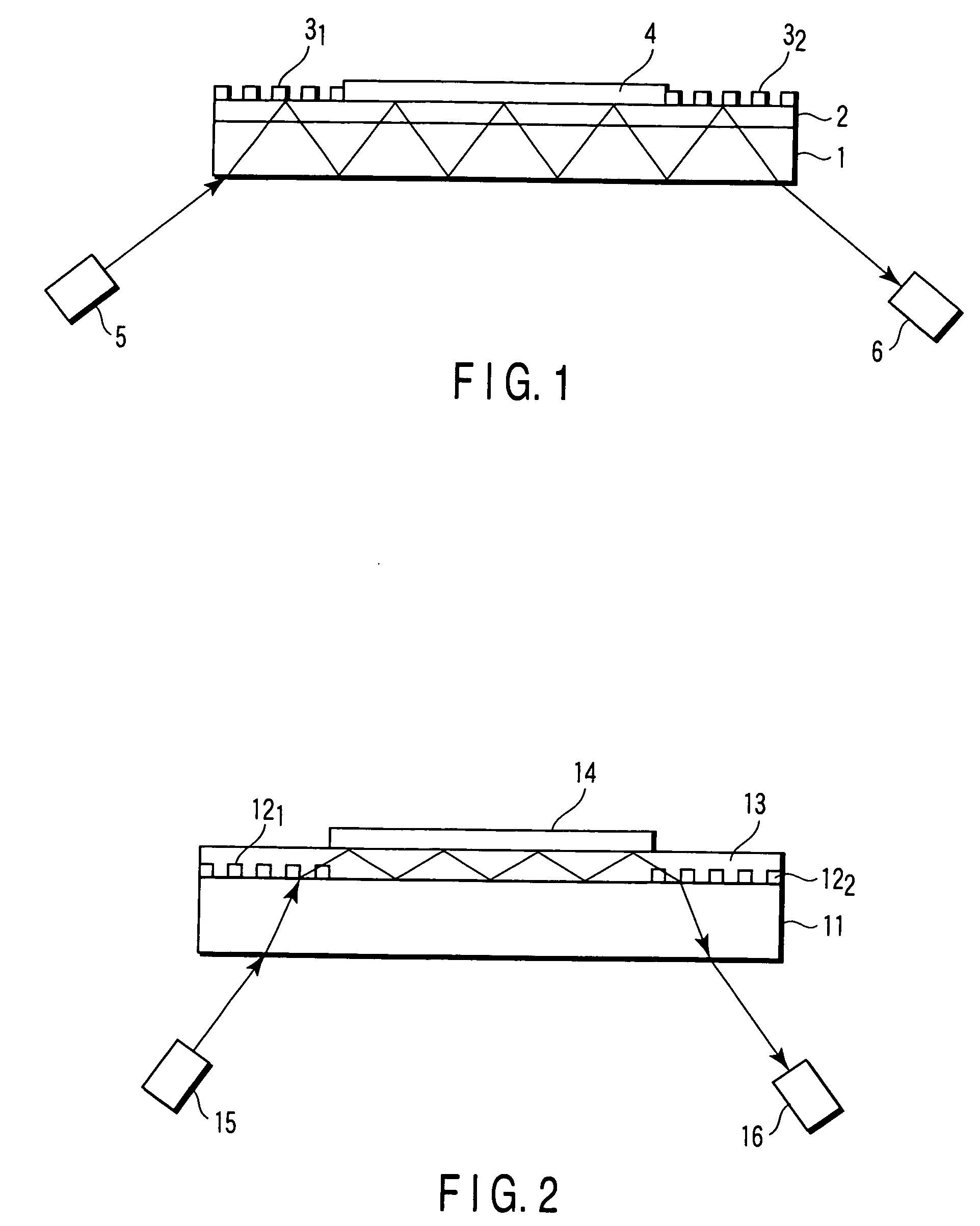Optical glucose sensor chip
- Summary
- Abstract
- Description
- Claims
- Application Information
AI Technical Summary
Benefits of technology
Problems solved by technology
Method used
Image
Examples
first embodiment
[0027]FIG. 1 is a cross sectional view showing a glucose sensor chip according to a first embodiment of the invention.
[0028] A glass substrate 1 has a SiO2 surface layer 2 with a thickness of, for example, 3 nm or more on the major surface. First and second gratings 31 and 32 as first and second optical elements, respectively, are formed at near both ends of the SiO2 surface layer 2. The fist grating 31 impinges a light into the substrate 1. The second grating 32 emits the light from the substrate 1 to the outside. The first and second optical elements may be replaced with prisms. The first and second gratings 31 and 32 are made of, for example, titanium oxide having a higher refractive index than the SiO2 surface layer 2. A protective layer (not shown) having a lower refractive index than the refractive indices of the fist grating 31 and second grating 32 may be formed so as to cover the first and second gratings 31 and 32. The protective layer is made of, for example, a fluorinat...
second embodiment
[0043]FIG. 2 shows a cross-sectional view of an optical sensor chip according to a second embodiment of the invention.
[0044] First and second gratings 121 and 122 as first and second optical elements, respectively, are formed at near both ends on the major surface of a glass substrate 11. The first grating 121 impinges a light into the substrate 11. The second grating 122 emits the light from the substrate 11 to the outside. The first and second gratings 121 and 122 are made of, for example, titanium oxide having a higher refractive index than the substrate 11. A light-reflecting waveguide layer 13 made of a thermosetting or light-curable resin having a higher refractive index than the substrate 11 is formed on the major surface of the substrate 11 including the first and second gratings 121 and 122. The major surface of the light-reflecting waveguide layer 13 is formed to be parallel to the major surface of the substrate 11.
[0045] A glucose sensing membrane 14 is formed on the po...
example 1
[0061] Mixed and stirred to prepare 4000 μL of a coating solution for forming a glucose sensing membrane were 1436 μL of isopropyl alcohol (IPA), 956 μL of pure water, 210 μL of phosphate buffer solution (0.01 mol / L, pH 6.0), 60 μL of isopropyl alcohol solution (1% by volume) of polyethyleneglycol, 600 μL of isopropyl alcohol solution of 3,3′,5,5′-tetramethylbenzidine (TMBZ: 1 mg / mL), 640 μL of aqueous solution (2% by weight) of carboxymethyl cellulose, 8 μL of aqueous solution (1% by weight) of a cross-linking polymer (a copolymer of 2-methacryloyloxyethyl phosphorylcholine and butyl methacrylate), 0.67 mg / mL of an aqueous peroxidase (POD) solution (dissolved in 0.01 mole / L of phosphate buffer solution, pH 6.0), and 5.33 mg / mL of an aqueous glucose oxidase (GOD) solution (dissolved in 0.01 mole / L of phosphate buffer solution, pH 6.0).
[0062] Subsequently, a non-alkaline glass substrate having a SiO2 surface layer with a thickness of 10 nm on the major surface and a refractive index...
PUM
| Property | Measurement | Unit |
|---|---|---|
| thickness | aaaaa | aaaaa |
| thickness | aaaaa | aaaaa |
| thickness | aaaaa | aaaaa |
Abstract
Description
Claims
Application Information
 Login to View More
Login to View More - R&D
- Intellectual Property
- Life Sciences
- Materials
- Tech Scout
- Unparalleled Data Quality
- Higher Quality Content
- 60% Fewer Hallucinations
Browse by: Latest US Patents, China's latest patents, Technical Efficacy Thesaurus, Application Domain, Technology Topic, Popular Technical Reports.
© 2025 PatSnap. All rights reserved.Legal|Privacy policy|Modern Slavery Act Transparency Statement|Sitemap|About US| Contact US: help@patsnap.com



